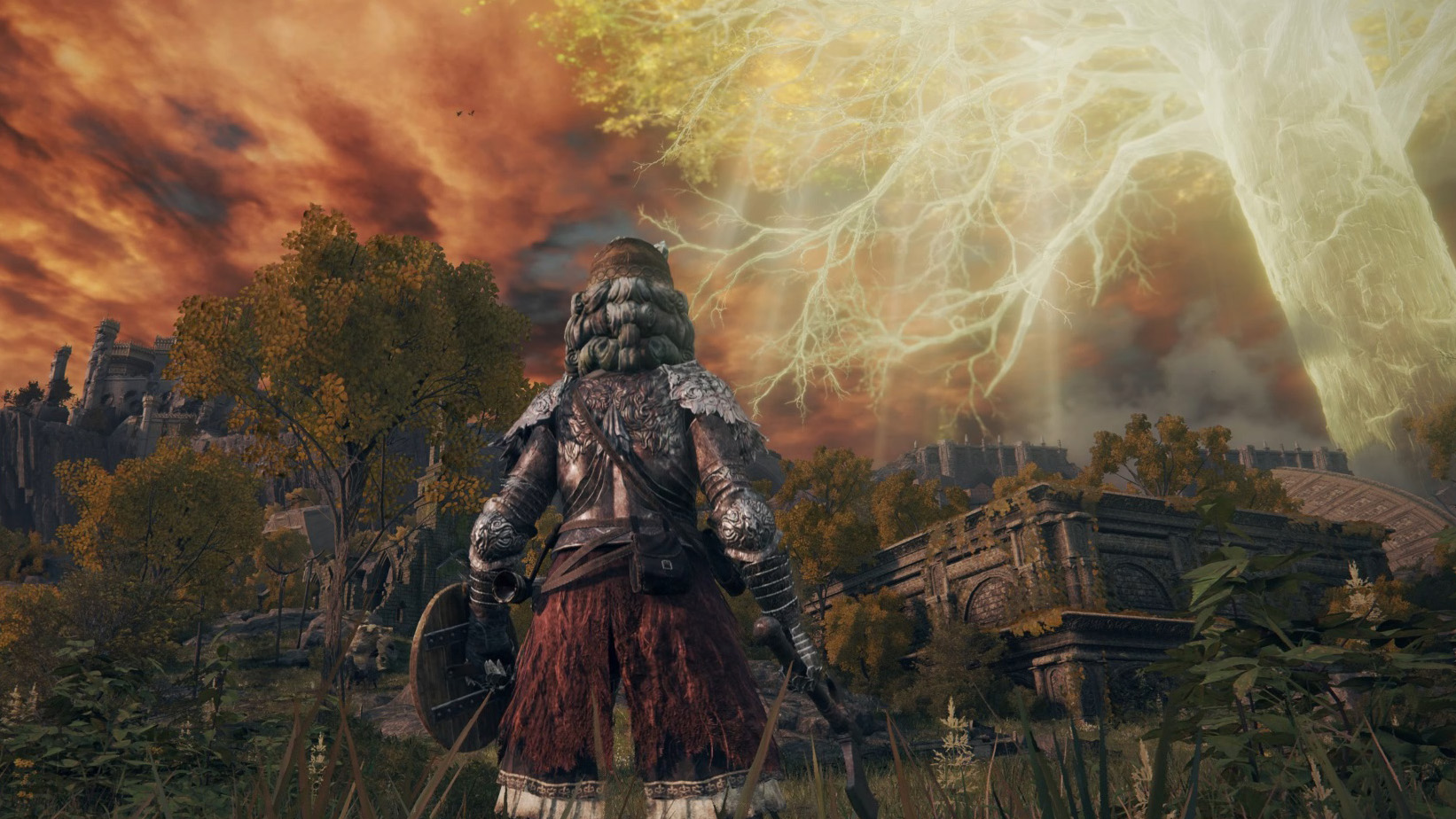After 10 hours with Elden Ring, I'm not sold on the open world
Elden Ring's freeform exploration is liberating, but there sure is a lot of empty space.

I began my search for the Elden Ring by running away from a knight on horseback that was five times my size. He was resplendent in golden armor, and I had the feeling that my wooden club, rags, and the wagon wheel around my neck wouldn't measure up to the man-sized halberd he was swinging in the air. So I ran, picking up a few berries from bushes along the way, and kept walking until I found some enemies that were more my size. Within an hour I'd gone underground into a small dungeon, killed my first boss, and been granted a spectral steed that could tear across the fields of Elden Ring's open world at a mighty pace.
The spectral steed is important, because the impression I got from a weekend of early access to the Elden Ring Network Test is that I'll be doing a lot of tearing across empty fields in the final game. Elden Ring's open world is rich with loot and mini dungeons to find, but after a decade of exploring FromSoftware's tightly designed kingdoms, it's a shock to see just how spread out everything is in Elden Ring.
The network test didn't convince me it was a worthy trade.
There's a tension at the heart of Elden Ring that FromSoftware's never had to deal with before. As I wrote about in-depth in my article on what I liked and didn't like in Elden Ring, it's shaping up to be the most freeform and flexible RPG From's ever made. From the very beginning you can go off in whatever direction you want, which feels far more freeing than picking one of the two or three paths available from Firelink Shrine as Dark Souls begins. With the steed, you can easily avoid enemies that are too strong for you while you strike out searching for treasure. If you're the type of RPG player who loves coming up with creative builds and optimizing a new run around getting the perfect gear as quickly as possible, Elden Ring holds great promise for you.
But I'm worried that freedom means we're going to see a lot less of FromSoftware's traditionally great level design, and that the open world is more filler than new play space.

Elden Ring guide: Conquer the Lands Between
Elden Ring bosses: How to beat them
Elden Ring dungeons: How to defeat them
Elden Ring paintings: Solutions and locations
Elden Ring map fragments: Reveal the world
When I think about what makes me compelled to explore open world games, a few things come to mind. One is being able to interact with or affect the world in meaningful ways. There will be a hundred articles pitting Elden Ring against The Legend of Zelda: Breath of the Wild, so I won't linger on the comparison—the important takeaway is that Breath of the Wild was absorbing because the tools it gave you tied in with systems like gravity and temperature; stumbling upon something mysterious was more often a freeform puzzle to solve than an enemy to fight. FromSoft's games are about combat above all, and they've always done that brilliantly, but it means there's inevitably very little to interact with in the open world. You arrive at the crest of a hill, spend a moment appreciating the view, and then look to see what's in need of a good killing.
Quests also push me to explore open worlds. In The Witcher 3, I loved seeing where a new bit of story would take me, and how a quest about a tragic werewolf stalking a village or a specter haunting a mansion would enrich my understanding of the game world. Again, Elden Ring deliberately doesn't have those things. Its open world is connective tissue, and only engaging when it contains unique things to discover that make it worth slowing down for a moment.
Keep up to date with the most important stories and the best deals, as picked by the PC Gamer team.
I did find some of those in Elden Ring's opening area, like an enormous wagon being hauled by two giants, chained spears piercing their torsos. A procession of knights and undead trailed behind it, and killing them all awarded me with the wagon's treasure: a set of heavy armor. There was the mechanical golem that lumbered to life when I rode past it, and the dragon that swooped down from the sky when I entered the swamp, initiating a battle that was clearly designed to be fought from horseback.
Cool discoveries, but all could've worked just as well in more traditional Souls levels. The small dungeons that pockmark the open world are mostly corridors with a few enemies and then a boss. Aside from the bosses, they seem destined to be forgotten, which I wouldn't say about many Souls areas—even the bad ones are usually memorable.

What's impossible to tell from the limited area available in the Network Test is how well Elden Ring's "Legacy Dungeons" will complement the open world's sprawl. These are meant to be dense areas that bring back the intertwining hallways and catacombs FromSoftware has always done well. Only part of one, Stormveil Castle, is explorable in the Network Test; it looked impressive from the outside but cut me off too soon to know if it's full of the same satisfying shortcuts and side paths as From's best locations.
Given how truly massive the open world in Elden Ring looks to be—I may have only played something like 5% of the full world map—how many Legacy Dungeons could there be? Enough to feel like truly substantial chunks of the world, or will they just be pit stops along the way?
Maybe Elden Ring is the rare game where the destination matters more than the journey. In the Network Test I had free reign to explore in any direction I chose, but before too long I'd run into a fog wall that penned me in—FromSoftware's way of holding back the full experience for next February. Within the corner of the open world I could explore, Elden Ring never conjured that feeling of going on a journey, of crossing immense distances and looking back with awe at how far I'd traveled. I did circle back to that golden knight a few hours later and kill him with a half dozen magic attacks, after piling points into my faith stat and finding a much better shield. But that was a short ride and an easy win, not an achievement dozens of hours in the making.
Without puzzles or quests, maybe sheer scope and variety and the doomed majesty of FromSoftware's decaying fantasy aesthetic will be enough to make its open world as memorable as Lordran or Yharnam. Maybe there are more small dungeons out there with surprising depth not found in this first area. FromSoftware rarely likes to show off its best material ahead of time—I hope that the key that gives its open world purpose is out there beyond the fog wall somewhere, waiting to be discovered.

Wes has been covering games and hardware for more than 10 years, first at tech sites like The Wirecutter and Tested before joining the PC Gamer team in 2014. Wes plays a little bit of everything, but he'll always jump at the chance to cover emulation and Japanese games.
When he's not obsessively optimizing and re-optimizing a tangle of conveyor belts in Satisfactory (it's really becoming a problem), he's probably playing a 20-year-old Final Fantasy or some opaque ASCII roguelike. With a focus on writing and editing features, he seeks out personal stories and in-depth histories from the corners of PC gaming and its niche communities. 50% pizza by volume (deep dish, to be specific).

